| |
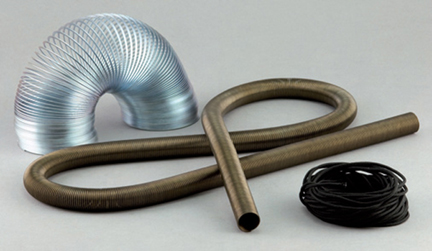 Click to Enlarge
Click to Enlarge
|
Spring Set (0780)
Specifications : Wave Form Helix (Slinky), diameter 8 cm, unstretched length 13 cm, may be stretched to approximately 5 m Helix Spring, diameter 2 cm, unstretched length 1 m. COMPONENTS : • Wave Form Helix (Slinky) • Helix Spring • Cord. LAWS & PRINCIPLES INVESTIGATED : Logitudinal and transversal waves.
See Enlarge
|
|
|
|
 Click to Enlarge
Click to Enlarge
|
Wave Form Helix (0781)
Specifications : Diameter: 8 cm – Unstretched length: 13 cm, stretched length: approx 5 m. LAWS & PRINCIPLES INVETIGATED : • Logitudinal waves.
See Enlarge
|
|
|
|
 Click to Enlarge
Click to Enlarge
|
Helix Spring (0782)
Specifications : Diameter: 2 cm – Unstretched length: 1 m. LAWS & PRINCIPLES INVESTIGATED : • Transversal waves.
See Enlarge
|
|
|
|
 Click to Enlarge
Click to Enlarge
|
Melde’s Apparatus (0783)
Specifications : Size: 25 x 18 x 7 cm – Weight: approx. 1.6 kg. A simple experiment to study standing waves on a string. The Melde’s Apparatus is a simple way to introduce students to the concept of standing waves. The apparatus consists of a string and an oscillator to generate different frequencies. Melde’s experiment is ideal to study the behaviour of standing waves. You can even visually determine wavelength, period and amplitude of waves. COMPONENTS : • Wave generator base • Metal rod with hook • U-shaped magnet • Clamp • Weight holder • String • Mass, 50 g. LAWS & PRINCIPLES INVESTIGATED : • Standing waves on a string.
See Enlarge
|
|
|
|
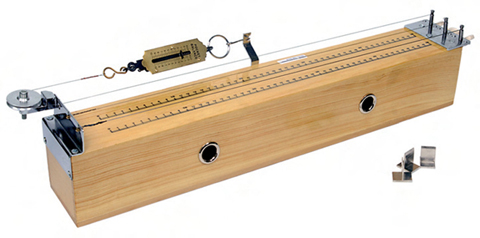 Click to Enlarge
Click to Enlarge
|
Three-Wire Sonometer (0784)
Enquiring the laws of the vibrating string. Specifications : Size: 67 x 10 x 10 cm
Weight: approx. 1.5 kg. Appealing and elegant, the Sonometer is a classical device developed in order to study vibrating strings. With this apparatus it is possible to investigate the dependence of the pitch on the length, tension and thickness of a vibrating string. LAWS & PRINCIPLES INVESTIGATED : • Vibration frequency of a stretched string as a function of the length, tension and density of the string • Frequency versus length • Frequency versus tension • Frequency versus mass per unit of length.
See Enlarge
|
|
|
|
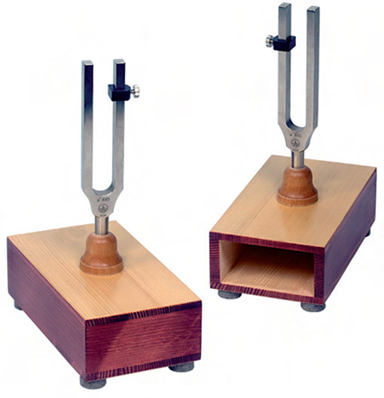 Click to Enlarge
Click to Enlarge
|
Pair of LA3 Tuning Forks (0785)
Specifications : Size: approx. 14 x 7 x 20 cm each – Weight: approx. 0.4 kg each. A pair of mounted tuning forks for interference and resonance experiments. Tuning forks are a standard tool in school laboratories helping students to understand the relationship between wave frequency and pitch. The tuning forks can be used to perform several experiments. Ideal for determining the wave frequency (can be used with a data logger and sound sensor) and the pitch. These high quality aluminium forks are mounted on a base to enhance the resonant sounds. Complete with rubber mallet. COMPONENTS : • LA3 tuning fork (2x) • Resonance box for tuning forks (2x) • Rubber mallet • Sliding masses on fork. LAWS & PRINCIPLES INVESTIGATED : • Use of the tuning forks • Resonance • Interference • Beats.
See Enlarge
|
|
|
|
 Click to Enlarge
Click to Enlarge
|
Set of Tuning Forks (0786)
Set of Tuning Forks for a wide range of experiments. Specifications : Size: 25 x 21 x 7 cm – Weight: approx. 0.8 kg Packing: ABS carry case with foam inserts. The Set of Tuning Forks contains eight tuning forks representing a full octave of frequencies, a soft protective case and a rubber mallet. You can also study resonance, interference, beats and the relationship among them. The set also contains tuning forks of exact multiple frequencies of each other (for example 256 Hz and 512 Hz), allowing you to perform interesting experiments in harmonics. COMPONENTS : • Tuning fork c1, 256 Hz • Tuning fork d1, 288 Hz • Tuning fork e1, 320 Hz • Tuning fork f1, 341.3 Hz • Tuning fork g1, 384 Hz • Tuning fork a1, 426.6 Hz • Tuning fork h1, 480 Hz • Tuning fork c2, 512 Hz • Rubber mallet. LAWS & PRINCIPLES INVESTIGATED : • Measure the frequency and period of sound waves from tuning forks • Measure the amplitude of sound waves from tuning forks • Investigating resonance, interference and beats.
See Enlarge
|
|
|
|
 Click to Enlarge
Click to Enlarge
|
Resonance Apparatus (0787)
Specifications : Size: 30 x 20 x 104 cm – Weight: approx. 3.2 kg Mounted on base. Demonstrating standing waves. The Resonance Apparatus allows you to observe the resonance phenomena and to measure the speed of sound in air by exploiting standing wave and resonance effects in longitudinal waves. COMPNENTS : • Stand for Resonance Apparatus • Levelling Bulb (1000ml)
• Rubber tube • Resonance tube • Knob (Policarbonate, Yellow) M5 x 10 mm (2x) • Sliding Support with 2 holes. LAWS & PRINCIPLES INVESTIGATED : • Resonance • Resonance points for a certain frequency and their relation with the standing wavelength • Measurement of the speed of sound in air • Measurement of the wavelength of the incoming wave
See Enlarge
|
|
|
|
 Click to Enlarge
Click to Enlarge
|
Gravesande Ball and Ring (0788)
Specifications : Length of the bar 130 mm – Length of the chain 100 mm. Simple and effective piece of equipment for qualitative experiments. A concrete demonstration of the cubic thermal expansion of a solid. Ring and ball on chain with 2 wooden handles. The ball passes through the ring when cold but will not pass through after being heated. LAWS & PRINCIPLES INVESTIGATED : • Cubic thermal expansion of solids.
See Enlarge
|
|
|
|
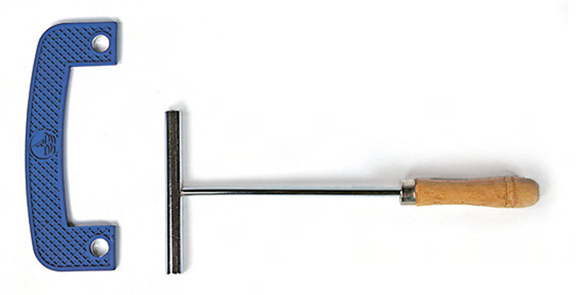 Click to Enlarge
Click to Enlarge
|
Bar and Gauge (0789)
Specifications : Steel bar: length 110 mm, diam. 12 mm, Rod with wooden handle: length 200 mm. Simple instrument to show thermal expansion of solids. For demonstration of solids expansion. Steel bar on rod with wooden handle. U-shaped gauge, sliding fit over ends of bar, with holes 12 mm bore. LAWS & PRINCIPLES INVESTIGATED : • Solid expansion.
See Enlarge
|
|
|
|
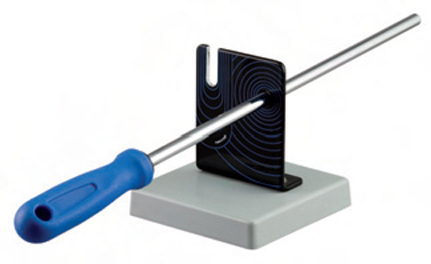 Click to Enlarge
Click to Enlarge
|
Thermal Expansion Bar (0790)
Specifications : Plastic base: dimensions approx. 12 x12 cm. Simple and effective piece of equipment to show thermal expansion. A model to demonstrate the change of diameter of a metal rod when heated including brass rod with insulated handle. Mounted on sturdy shock resistant plastic base. COMPONENTS : • Brass Rod (with insulated handle) • Metal Plate with Base. LAWS & PRINCIPLES INVESTIGATED : • Thermal expansion. LAWS & PRINCIPLES INVESTIGATED : • Thermal expansion • Tensions due to expansion and contraction.
See Enlarge
|
|
|
|
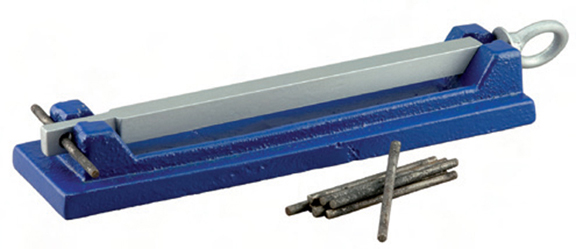 Click to Enlarge
Click to Enlarge
|
Pin Shearing Apparatus (0791)
Specifications : Dimensions: approx. 40 x 9 x 6 cm. Simple instrument to show forces of thermal contraction. This effective piece of equipment shows Dramatically the forces of thermal contraction. Constituted of a metal bar mounted on a sturdy metal base; the bar extends when heated and offers room to place the cast iron pin; the pin will break during cooling (i.e. Contraction). Equipped with a set of cast iron pins. COMPONENTS : • Metal Base • Metal Bar (with hole and screw) • Cast iron pins set.
See Enlarge
|
|
|
|
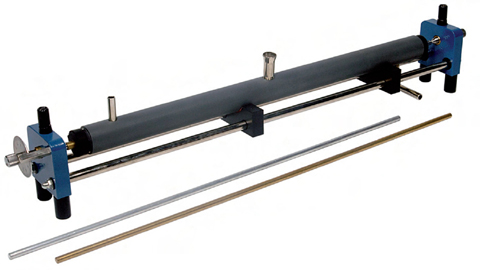 Click to Enlarge
Click to Enlarge
|
Gunther Expansion Apparatus (0792)
Specifications : Size: 62 x 8 x 12 cm – Weight: approx. 2.2 kg. Gunther Expansion Apparatus, can be used to accurately and easily investigate the expansion of metals with increasing temperature. This is an ideal apparatus for determinating the coefficient of the linear expansion of a solid. The apparatus comprises of a double metal plastic jacket containing the rods
which will be raised to a temperature of 100?C. A micrometer screw gauge is
mounted at one end and will show any expansion of the rods. COMPONENTS : • Gunther Apparatus • Metal Rods Set (Brass, Aluminium, Iron) • Thermometer (-10 to 110?C ). LAWS & PRINCIPLES INVESTIGATED : • Linear thermal expansion.
See Enlarge
|
|
|
|
 Click to Enlarge
Click to Enlarge
|
Compound Bar (0793)
Specifications : Length 300 mm. Simple instrument to study thermal expansion. Demonstrates how the unequal expansion of different metals may be used for practical applications (principle of bimetallic thermostats, switches, etc.). With wooden handle. LAWS & PRINCIPLES INVESTIGATED : • Expansion of solids • Functioning of thermostats.
See Enlarge
|
|
|
|
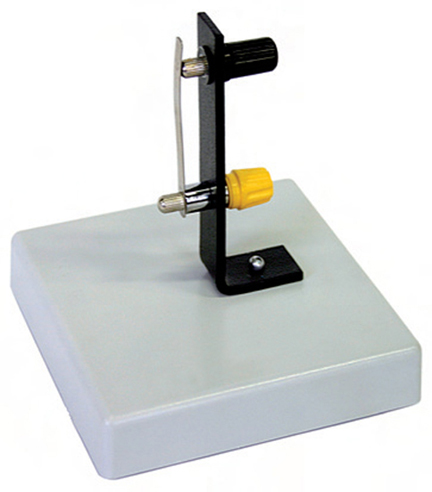 Click to Enlarge
Click to Enlarge
|
Bimetal Strip with Electric Contact (0794)
Specifications : Size: 10 x 10 x 12 cm – Weight: approx. 150 g. Simple demonstrator for thermal expansion. A simple device that shows how we can use two different metals joined together to produce a thermostat. The apparatus consists of a bimetal strip that expands differently on both sides
due to two different materials. Once heated, it will bend to one side as one of the metals will expand faster than the other. LAWS & PRINCIPLES INVESTIGATED : • Thermal expansion • Demonstraton model of thermostat.
See Enlarge
|
|
|
|







